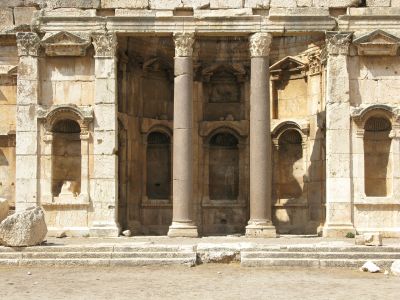The Hexagonal Forecourt at Baalbek Ruins, Lebanon
Historical Significance
The ancient city of Baalbek, located in the Bekaa Valley of Lebanon, is a testament to the architectural mastery and religious significance of several ancient civilizations. Predominantly associated with the Roman Empire, the Baalbek ruins, with structures such as the Hexagonal Forecourt, have been a focal point of global tourism, reflecting the grandeur of Roman architecture and the enigmatic appeal of pre-Roman civilizations.
Baalbek, originally known as Heliopolis during the Hellenistic period, was a major center for worship and became a cornerstone for subsequent Roman colonization and expansion. The Hexagonal Forecourt is part of the monumental entrance to the Jupiter temple complex, which was one of the largest sanctuaries in the empire. Its history spans centuries, reflecting not just the Roman influences but also earlier ones possibly related to Phoenician and other pre-Roman cultures that worshipped at the site.
Tourism History
Tourism in Baalbek has a complex history. During the 19th and early 20th centuries, Baalbek attracted Western travelers and scholars fascinated by its grand ruins. It was featured prominently on the itineraries of European tourists undertaking the cultural Grand Tour. However, periods of conflict within Lebanon have at times made the site less accessible to tourists.
Despite such challenges, Baalbek has remained one of Lebanon's premier tourist attractions. The Lebanese government and international organizations have undertaken concerted efforts to preserve the site and manage it for tourist visitation. The annual Baalbek International Festival, which showcases performances by Lebanese and international artists amid the ruins, has been instrumental in keeping tourism alive in the region.
Latest Tourism Trend
In recent years, there has been a trend towards sustainable and responsible tourism in destinations such as Baalbek. Visitors are increasingly interested in learning about the historical context and significance of the ruins while supporting the local economy and preserving the site.
Moreover, virtual tourism has become a noteworthy trend amidst global conditions that have restricted travel. Through digital means, aficionados of history and architecture can explore the wonders of the Hexagonal Forecourt and the wider complex of the Baalbek ruins from anywhere in the world.
Visiting the Hexagonal Forecourt
When visiting the Baalbek ruins and the Hexagonal Forecourt, tourists are encouraged to engage with local guides who offer insight into the historical importance of the site and its many layers of history. Exploration of the site is not just a journey through ancient times, but also a support to the local community that is a custodian of these timeless treasures.



















